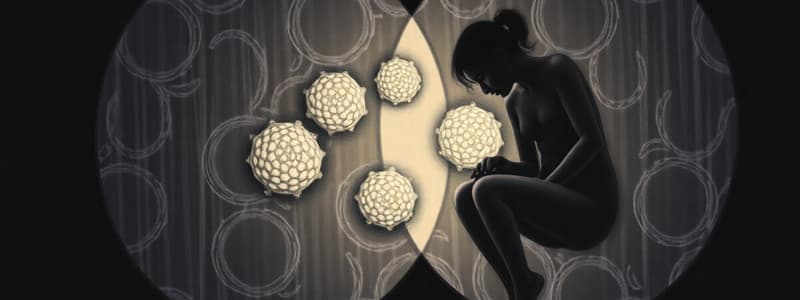Podcast
Questions and Answers
What is produced during meiosis?
What is produced during meiosis?
- Three diploid gametes
- Four haploid daughter cells (correct)
- One diploid zygote
- Two diploid cells
Which of the following processes occurs during prophase I of meiosis?
Which of the following processes occurs during prophase I of meiosis?
- Replication of DNA
- Homologous pairs form a tetrad (correct)
- Separation of sister chromatids
- Formation of a diploid zygote
Which mechanism does NOT contribute to genetic variation during meiosis?
Which mechanism does NOT contribute to genetic variation during meiosis?
- Random fertilization
- Crossing over
- Independent assortment
- DNA replication (correct)
What distinguishes meiosis from mitosis?
What distinguishes meiosis from mitosis?
What role does crossing over play during meiosis?
What role does crossing over play during meiosis?
What is the term for an organism with an abnormal number of chromosomes due to missing a normal copy?
What is the term for an organism with an abnormal number of chromosomes due to missing a normal copy?
In humans, what is the genetic condition known as trisomy 21 most commonly associated with?
In humans, what is the genetic condition known as trisomy 21 most commonly associated with?
What is the chromosome set condition for a diploid organism?
What is the chromosome set condition for a diploid organism?
What is the result of nondisjunction during meiosis?
What is the result of nondisjunction during meiosis?
Which statement accurately describes polyploid organisms?
Which statement accurately describes polyploid organisms?
What is the possible number of random alignments of homologous chromosomes during metaphase I in humans?
What is the possible number of random alignments of homologous chromosomes during metaphase I in humans?
What term describes an organism with the normal diploid number of chromosomes?
What term describes an organism with the normal diploid number of chromosomes?
Which of the following options best describes polyploidy?
Which of the following options best describes polyploidy?
In which animals is polyploidy most commonly found?
In which animals is polyploidy most commonly found?
What effect can variations in chromosome number have on species?
What effect can variations in chromosome number have on species?
Flashcards
Meiosis
Meiosis
A process that produces haploid cells from a diploid cell, enabling sexual reproduction.
Sexual Reproduction
Sexual Reproduction
A type of reproduction where two haploid gametes fuse to form a diploid zygote.
Tetrad
Tetrad
A structure formed by the pairing of homologous chromosomes during meiosis.
Crossing Over
Crossing Over
Signup and view all the flashcards
Genetic Variation
Genetic Variation
Signup and view all the flashcards
Homologous Chromosomes
Homologous Chromosomes
Signup and view all the flashcards
Crossing Over
Crossing Over
Signup and view all the flashcards
Chromosome Variation
Chromosome Variation
Signup and view all the flashcards
Polyploidy
Polyploidy
Signup and view all the flashcards
Euploid
Euploid
Signup and view all the flashcards
Aneuploidy definition
Aneuploidy definition
Signup and view all the flashcards
Down Syndrome cause
Down Syndrome cause
Signup and view all the flashcards
Trisomy
Trisomy
Signup and view all the flashcards
Monosomy definition
Monosomy definition
Signup and view all the flashcards
Nondisjunction
Nondisjunction
Signup and view all the flashcards
Study Notes
Meiosis and Sexual Reproduction
- Sexual reproduction involves fertilization, where two haploid gametes combine to form a diploid zygote.
- Meiosis is the process that produces haploid cells from an original diploid cell.
Stages of Meiosis
-
Meiosis involves one round of DNA replication followed by two nuclear divisions.
-
Meiosis I reduces the chromosome number.
- In prophase I, homologous pairs of sister chromatids form tetrads (bivalents) through synapsis.
- Crossing over, the exchange of genetic material between non-sister chromatids, occurs at chiasmata.
- In metaphase I, bivalents align randomly along the metaphase plate.
- In anaphase I, homologous chromosomes separate and move to opposite poles.
- In telophase I and cytokinesis, the chromosomes decondense, and the nuclear envelope reforms, producing two haploid daughter cells.
-
Meiosis II divides the sister chromatids.
- Prophase II: Sister chromatids condense, and the spindle starts to form. The nuclear envelope begins to break down.
- Prometaphase II: The nuclear envelope completely breaks down. Sister chromatids attach to the spindle via kinetochore microtubules.
- Metaphase II: Sister chromatids align along the metaphase plate.
- Anaphase II: Sister chromatids separate and individual chromosomes move toward opposite poles.
- Telophase II and cytokinesis: Chromosomes decondense, and the nuclear envelope reforms. Cleavage furrows separate the two cells into four haploid daughter cells.
Meiosis vs. Mitosis
- Mitosis produces two genetically identical diploid daughter cells.
- Meiosis produces four genetically different haploid daughter cells.
Mechanisms for Genetic Variation
- Crossing over in prophase I shuffles genetic material between homologous chromosomes.
- Random alignment of homologous chromosomes in metaphase I leads to different combinations of maternal and paternal chromosomes in daughter cells.
- Random fertilization further increases genetic variation, as any sperm can fertilize any egg.
Changes in Chromosome Number
- Euploidy: The normal number of chromosomes. Diploid (2n) organisms have two sets of chromosomes.
- Polyploidy: Organisms with more than two complete sets of chromosomes. This is common in some plants, but rare in animals.
- Triploidy (3n), Tetraploidy (4n).
- Aneuploidy: An abnormal number of particular chromosomes. This can result from nondisjunction (failure of chromosomes to separate properly during meiosis).
Nondisjunction
- Nondisjunction is the failure of chromosomes to separate properly during meiosis, which can result in gametes with extra or missing chromosomes.
Examples of Aneuploidy
- Trisomy 21 (Down syndrome): Three copies of chromosome 21.
- Monosomy: Missing one copy of a chromosome.
Studying That Suits You
Use AI to generate personalized quizzes and flashcards to suit your learning preferences.



